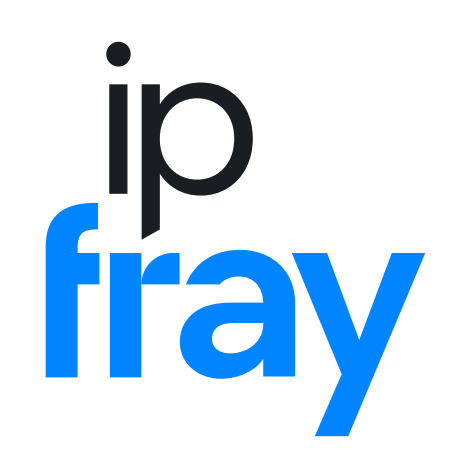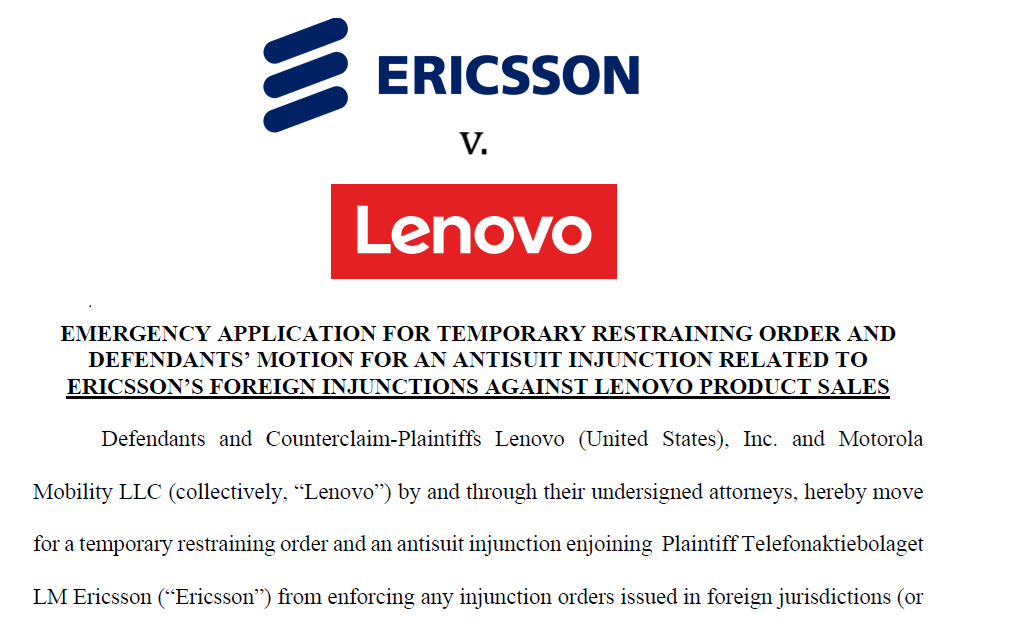Context: Lenovo’s motion in the Eastern District of North Carolina for an antisuit temporary restraining order (TRO) against Ericsson (previous article)
What’s new: On Tuesday, Ericsson filed an opposition brief that sheds light on Lenovo’s positions (such as a 23¢-per-device counteroffer and the refusal to sign a non-disclosure agreement without an enforcement standstill) and tactics (such as its pursuit of injunctive relief against Ericsson in multiple fora). Judge Terrence W. Boyle has scheduled a motion hearing for January 11.
Direct impact: Lenovo is effectively asking Judge Boyle not to protect his court’s jurisdiction, but that of the High Court of Justice in London, which is Lenovo’s preferred FRAND venue in this dispute. In the absence of apposite case law in that district and the Fourth Circuit, predictions are fraught with uncertainty, but Ericsson has a strong argument that Apple failed with similar arguments against Ericsson a year and a half ago in the patent-savvy Eastern District of Texas and has highlighted a variety of deficiencies in Lenovo’s motion.
Wider ramifications: Lenovo itself (other than its Motorola Mobility subsidiary) never took a license from Ericsson in over a decade, and with every new court filing, the plot is thickening that its overall conduct is hold-out of the most unreasonable kind. Such an instructive and illustrative case should give EU policy makers pause as they consider new SEP rules and could learn a lot from publicly available documents about how certain implementers act. Furthermore, the dispute shows that while the UK became a popular venue among net licensors after Unwired v. Huawei, and not long after Apple even threatened to withdraw from the UK market over its SEP jurisprudence, it is now astoundingly a net licensee’s preferred FRAND forum (after Optis v. Apple and InterDigital v. Lenovo), which could change again depending on certain UK appeals.
While it is unclear how Judge Boyle views the issues in the case, Lenovo’s antisuit TRO motion has not raised such incredibly alarming issues that he would have entered a TRO on the pleadings. Instead, he will hold a motions hearing on January 11 at 2 PM Eastern Time.
Ericsson’s opposition brief provides the most informative overview yet of the FRAND-related situation between the parties:
The unusually long period during which no license agreement was concluded must be attributable, in no small part, to the fact that Lenovo itself wasn’t a significant maker of wireless devices until it acquired Motorola Mobility, which had a 4G license in place with Ericsson. When 5G was adopted, Lenovo itself was sitting at the standard-setting table and didn’t object to Ericsson’s disclosure of its headline rate, as the opposition brief notes. And while Ericsson obviously had some other priorities in recent years (the renewals, in either case after short-lived litigation, with Samsung and Apple), the time had then apparently come when “enough was enough” and, after a 30-day period to accept an arbitration agreement had expired, infringement litigation commenced.
Lenovo’s conduct differs very significantly from what is known about Samsung and Apple (and various other net licensees as well) in comparable situations. That company takes extreme positions on standard-essential patent (SEP) licensing that, taken together with its pursuit of a U.S. antisuit injunction, would easily result in an unwillingness finding by a German court:
- A counteroffer of 23 U.S. cents per device is not serious.
- Lenovo insisted in its FRAND counteroffers on the inclusion of non-SEPs, for which there simply is no legal basis as non-SEPs aren’t FRAND-pledged, though a comprehensive portfolio license agreement is concluded for obvious practical reasons almost 100% of the time.
- A refusal to sign an NDA unless the net licensor agrees not to enforce is another example of hold-out extremism.
- While it is absolutely acceptable for a company to discuss the terms of an arbitration agreement, it appears that Lenovo didn’t even engage with Ericsson to potentially reach a mutually acceptable arbitration agreement.
- Looking at the global landscape of the dispute, it is clear that Lenovo ran to the court in North Carolina not to protect U.S. jurisdiction but because it wants the FRAND aspect of the case to be resolved in the UK.
- Lenovo brought various counterclaims in mid December, both in the U.S. (district court as well as ITC) and the UK, seeking its own injunctions against Ericsson.
- In different jurisdictions, Lenovo takes contradictory positions on whether or not its U.S. entity is its licensing agent.
- Lenovo’s Chinese parent company has refused service and has not entered an appearance in the U.S. case.
What Lenovo has been doing here serves as a textbook example of hold-out. There have been cases of hold-up, such as by Motorola Mobility (before Lenovo acquired that entity from Google) against Apple and Microsoft. But hold-out is also a reality, and any policy makers working on SEPs these days (particularly in the EU) should read those publicly available documents that are on the U.S. docket for the world to see in order to develop a better understanding of certain problems.
This is not the first time for Lenovo to seek an antisuit injunction. As Ericsson’s filing notes, Lenovo did so against German licensing firm IPCom in 2019, prompting French and UK anti-antisuit injunctions.
It is, however, the first time for Judge Boyle (and, on appeal, it will be the first time for the Fourth Circuit) to deal with these types of issues. Ericsson brought its case in that district because Lenovo’s U.S. operations are based there. Presumably, Ericsson sought to avoid the delay that could have resulted from a venue transfer.
Despite this antisuit motion being a first in that part of the United States, Ericsson’s opposition brief outlines plenty of reasons for which Lenovo’s motion should be denied. Counterintuitively, there even is an issue here with respect to whether the parties in the potentially enjoining U.S. case are essentially the same as in the potentially enjoined foreign proceedings. U.S. courts take a functional perspective, which is why this kind of argument never got traction in any of the previous SEP-related antisuit contexts. Here, however, the situation is such that Lenovo U.S. is described, by Lenovo itself, as merely a subsidiary of the Chinese parent company, just like the Latin American entities. Therefore, the U.S. entity does not control those companies. Lenovo can’t have it both ways. If the Chinese company had accepted the invitation to join the U.S. proceedings and/or if Lenovo consistently agreed that the U.S. entity is in charge of worldwide licensing for the entire group, Ericsson couldn’t argue that the entities differ between the proceedings in the various jurisdictions.
For lack of related case law in the Fourth Circuit, Judge Boyle could give more or less weight to the impact on international comity. Ericsson argues that even if the more permissive approach was applied, that impact would be intolerable and the motion would have to be denied. Judge Boyle is a Republican, and Ericsson describes the more restrictive circuits as the “conservative” ones. That leads to an oddity: the Fifth Circuit is not “liberal” in a political sense, and certain East Coast circuits are not “conservative” in that regard. But in the end, it is not about politics. Lenovo’s motion falls short of what would justify intervention by a U.S. court in Latin American proceedings, and Apple actually had less weak a case for that in 2022 than Lenovo does now.
In the comity context, Ericsson’s lawyers are correct that anti-antisuit injunctions by various jurisdictions show that antisuit injunctions interfering with their patent jurisdictions are viewed very negatively by foreign judges. That, of course, does not mean to say that antisuit injunctions should never issue. There have been cases in which a strong case was made, but this is none of them. As Ericsson’s opposition brief notes, the way to dispose of a licensing dispute is a license agreement, and Lenovo retains all options with respect to the U.S. case in question. Lenovo may be more prepared to commit to the outcome of a UK FRAND determination, but if that is so, then the logical thing would have been for Lenovo to seek an antisuit injunction in the UK (where it merely asked Justice Meade for some declaratory relief to use in the Brazilian proceedings).
Lenovo is not merely trying to stretch the envelope but taking extremist positions that will not be viewed favorably in various patent jurisdictions, including some traditional ones like Germany (in Munich, the pursuit of antisuit injunctions can be sufficient to be deemed an unwilling licensee) as well as up-and-coming ones like Brazil and Colombia.

